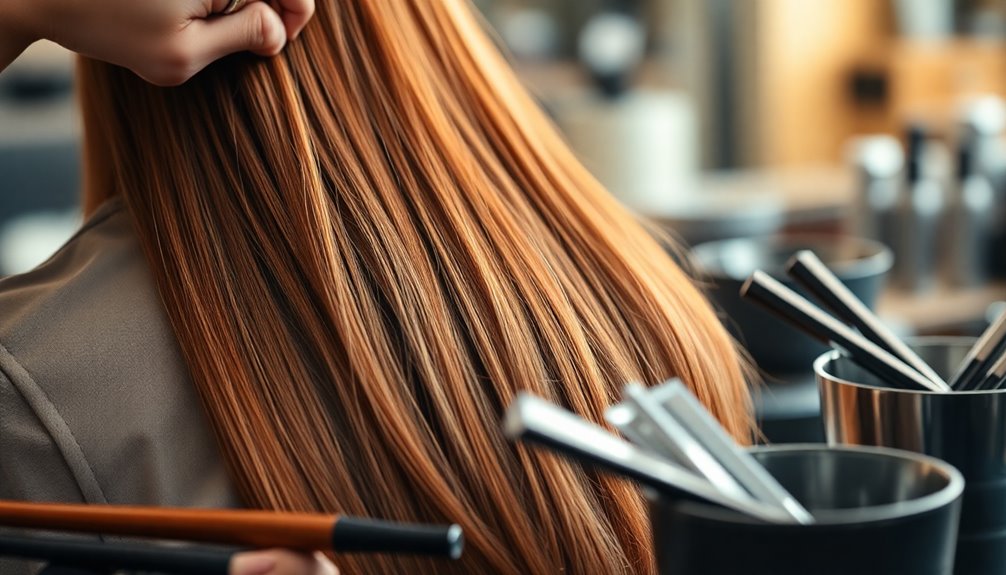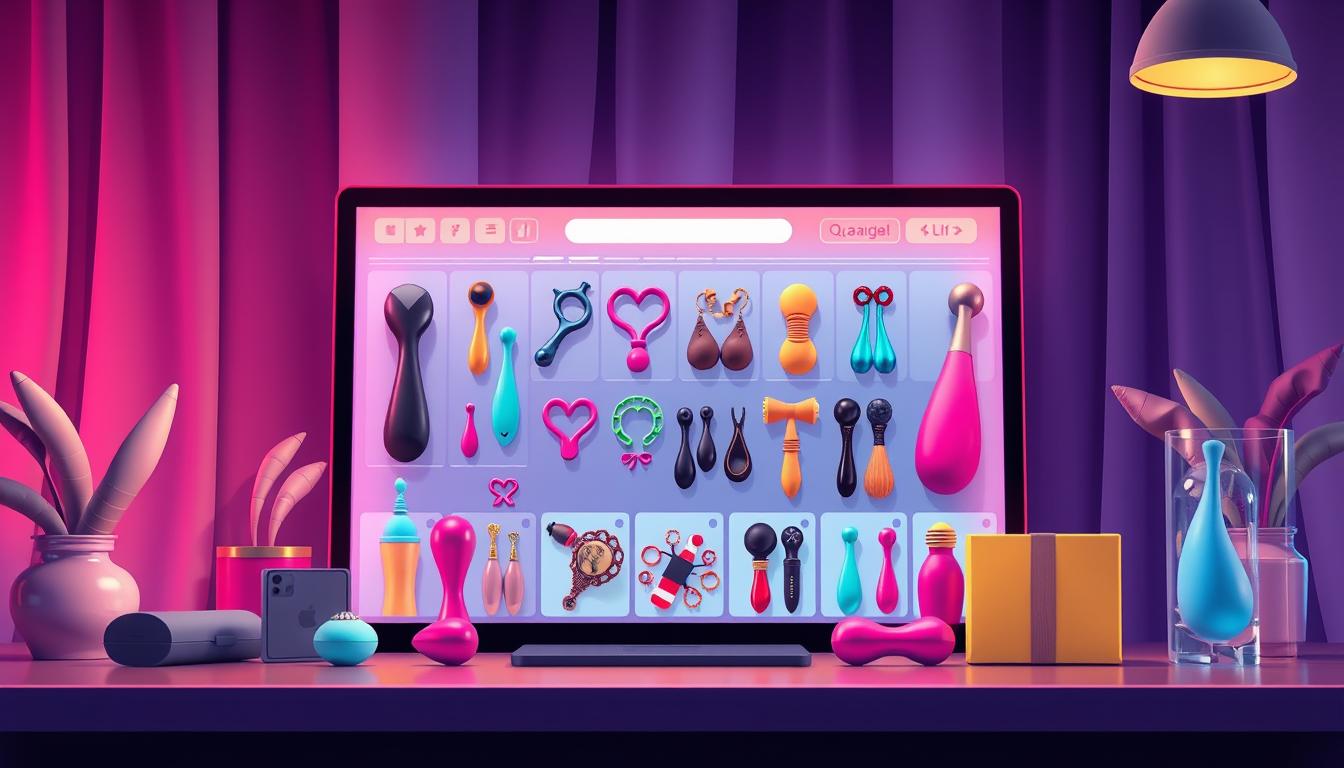To keep your balayage looking fresh, schedule touch-ups every 3-4 months. This timeframe accounts for about 1 inch of hair growth per month. Watch for signs like noticeable root growth, color fading, and dull highlights. If your hair feels dry or shows split ends, it's time for some extra care. After the initial treatment, you should wait 48-72 hours before washing. Don't forget to use sulfate-free products and consider deep conditioning weekly for moisture. If you're curious about adjusting your maintenance plan or learning more about full recolors, there's plenty more to explore!
Key Takeaways
- Schedule root touch-ups every 3-4 months to maintain vibrant balayage color as hair grows about 1 inch per month.
- Monitor for signs of fading, dullness, or contrasting regrowth lines to determine when touch-ups are needed.
- A full recolor may be necessary every 6-12 months if color appears dull or brassy, depending on hair growth.
- Prioritize hair health with deep conditioning treatments before and after balayage to enhance color absorption and retention.
- Regular salon visits and communication with stylists ensure personalized maintenance advice and timely assessments of hair health.
Understanding Balayage Maintenance

Maintaining your balayage is essential to keep your hair looking vibrant and healthy. First, regularly check for signs that your color needs care. If you notice color fading, especially in natural light, or if your highlights appear dull and brassy, it's time for color correction.
Dryness can also be a red flag; if your hair feels rough or tangles easily, it likely needs more moisture. Keep an eye out for split ends, as they can make your hair look unhealthy and lead to further damage. Additionally, if your roots are growing in and contrasting with the balayage color, that's another sign you should consider a touch-up. Regular trims can help maintain the overall health of your hair, ensuring the longevity and vibrancy of your balayage.
For home care, use sulfate-free shampoos and conditioners to protect your color. Limit washing to 2-3 times a week and opt for cool or lukewarm water to prevent stripping the color.
Incorporate deep conditioning treatments to hydrate your hair, and consider using dry shampoo between washes to keep it looking fresh. By following these guidelines, you can help maintain your balayage and keep your hair looking its best.
Frequency of Touch-ups
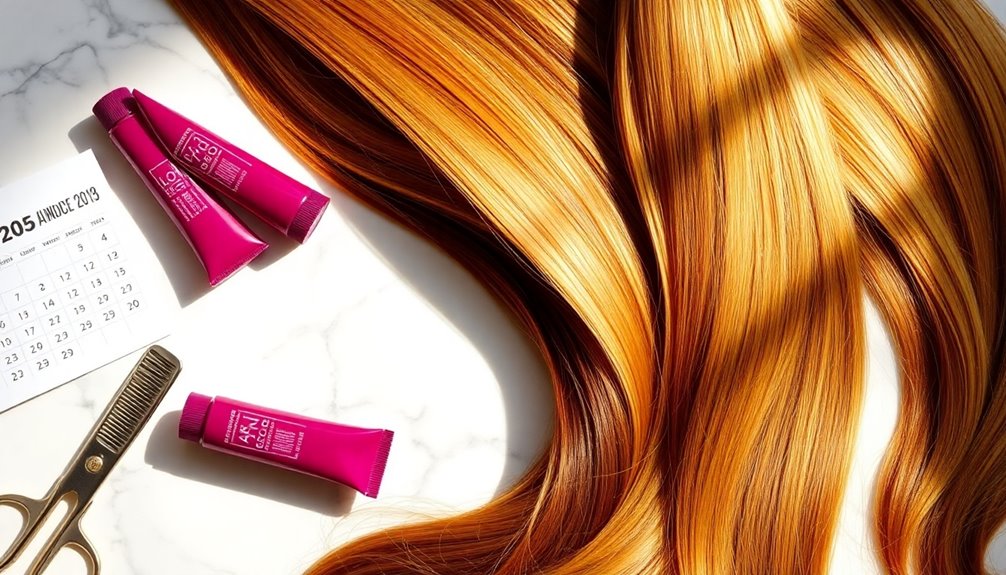
Touch-ups are a crucial part of keeping your balayage looking fresh and vibrant. Generally, you'll want to schedule your touch-ups every 3-4 months. This timeframe helps maintain that lively color you love.
While balayage can last up to 6 months for some, that's less common, and avoiding regular touch-ups might leave your hair looking dull and washed out. As your hair grows about an inch each month, touch-ups become essential for maintaining a seamless look.
The balayage technique allows for natural growth without a harsh regrowth line, but waiting too long can lead to an unnatural appearance. Deep conditioning treatments and proper hair care can help extend the time between touch-ups, so consider investing in color-safe shampoo and conditioner. Additionally, professional touch-ups are recommended to ensure your balayage stays vibrant and healthy.
Your hair type and personal washing habits will also influence how often you need touch-ups. Oily hair might require fewer washes, while dry hair may need more moisture to keep the color vibrant.
It's best to visit a stylist for professional touch-ups, as they can assess your hair's condition and offer additional treatments to keep your balayage looking stunning.
Signs You Need Touch-ups
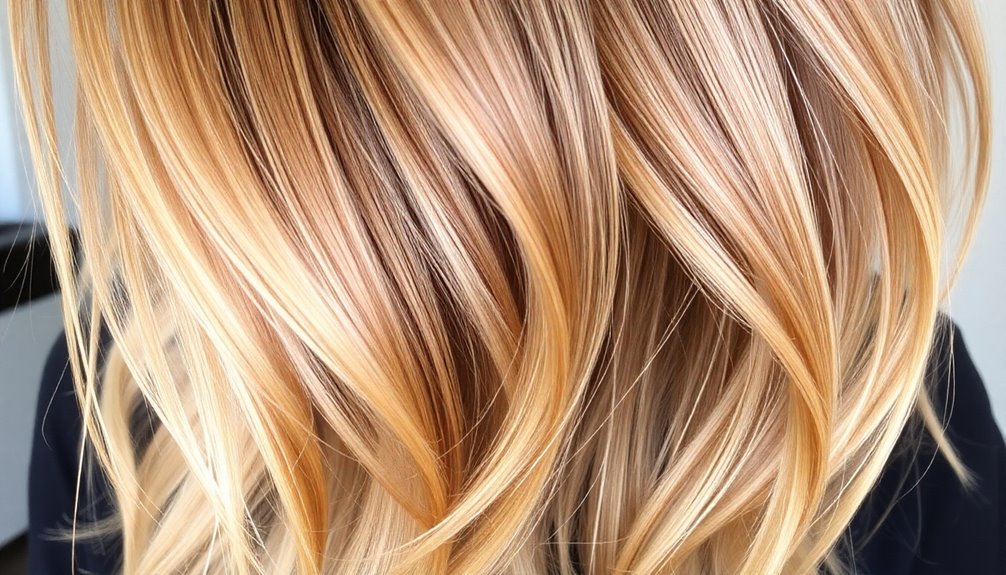
If you've noticed any changes in your balayage, it might be time to consider a touch-up. One of the first signs is visible regrowth lines, especially if your roots contrast sharply with your balayage color.
If your hair grows quickly, you may need touch-ups more often. A significant difference between your natural color and balayage can also prompt an earlier appointment.
Color fading can indicate it's time for a refresh. If your highlights look dull or have developed brassy tones, a toner refresh is necessary. Regular maintenance is crucial to combat color fading and dryness.
Uneven color or loss of shine means your balayage isn't looking its best.
Pay attention to your hair's health and texture. If it feels dry, has split ends, or is breaking more easily, those are clear signs you need to address your hair's condition.
Excessive frizz or a lack of elasticity also suggests it's time for a touch-up.
Pre-Treatment Preparation
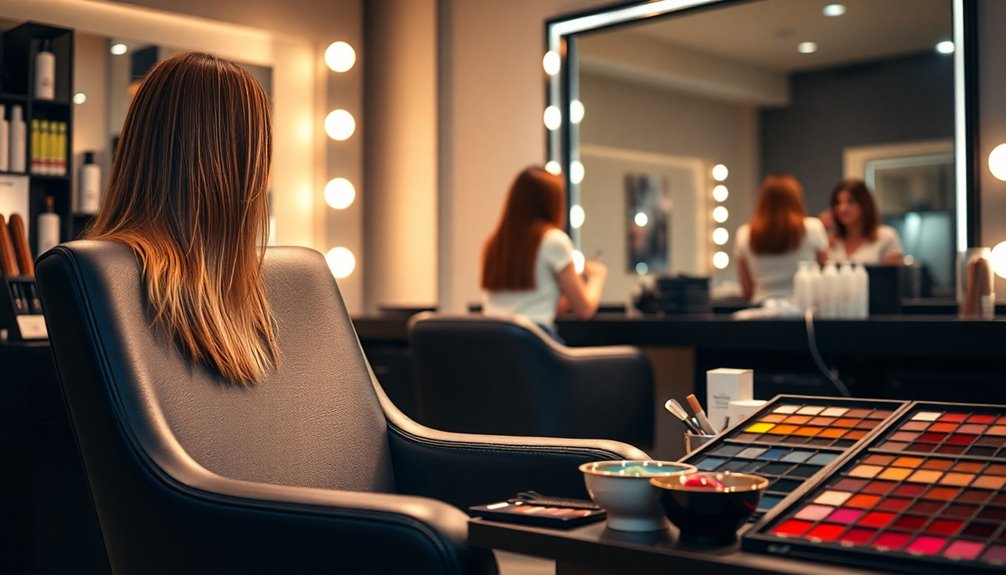
Before your balayage appointment, proper preparation can make a significant difference in the outcome. Start by avoiding washing your hair for a day or two before your visit. This will help your scalp's natural oils protect your hair during the chemical process.
Additionally, skip heat styling to give your locks a break from hot tools, allowing them to stay in their natural state for better results.
About a week prior, deep condition your hair to prep it for the treatment. Consider using a moisturizing mask to improve color absorption and retention. Waiting 48-72 hours after balayage before washing hair is also crucial for maintaining vibrant color.
When selecting products, opt for sulfate-free, color-safe shampoos and conditioners designed for color-treated hair.
If you've been using harsh chemical treatments, try to minimize those beforehand to reduce damage. If necessary, trim your hair to remove split ends, ensuring it's healthy enough for balayage.
Lastly, take the time to consult your stylist about any hair concerns or previous treatments. They can provide personalized recommendations on how to best prepare your hair for the upcoming transformation. Additionally, discussing your hair history can help your stylist understand the unique needs of your hair type. If you’re considering more drastic changes or treatments, they’ll be able to share valuable insights and techniques tailored just for you. For those curious about innovative options, make sure to ask about the latest trends—such as the ‘turkey hair transplant secrets revealed‘—that could offer fresh solutions for your hair journey.
Following these steps will set your balayage up for success!
Post-Treatment Care
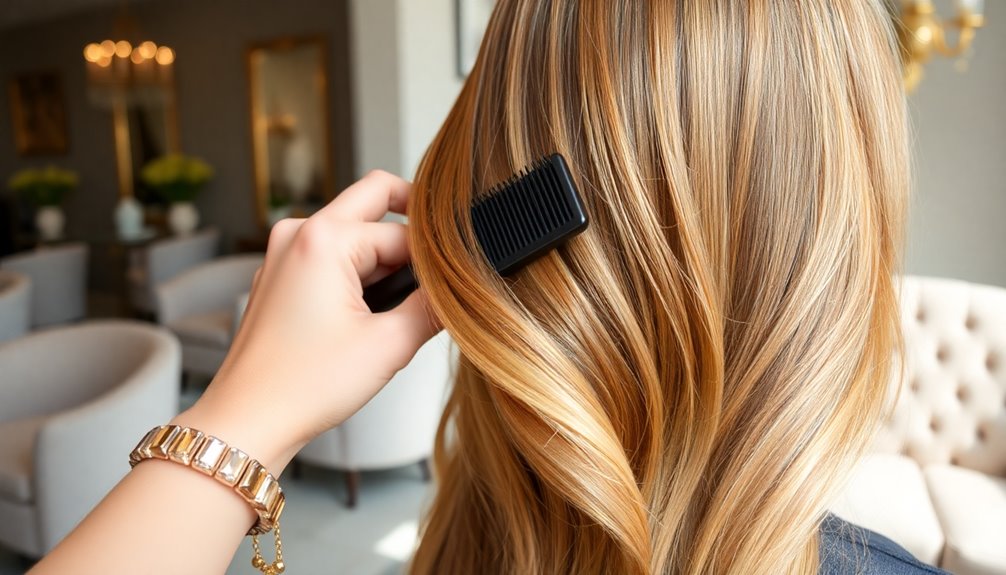
Ensuring your hair stays vibrant and healthy after balayage requires diligent post-treatment care. First, wait 48 to 72 hours before washing your hair. This waiting period allows the color to set and the cuticle to close, preventing premature fading. Washing too soon can damage your cuticle and diminish color retention. During this time, avoid heat styling and harsh treatments; patience is key.
Once you do wash your hair, opt for sulfate-free, color-safe shampoos and conditioners to help extend your color's longevity. Limit washing to 2-3 times a week and use lukewarm or cool water to protect your color. Incorporate a leave-in conditioner for extra moisture and protection against fading. Additionally, regular conditioning and hydration are crucial for maintaining the shine of balayage hair.
Moisture is crucial, so consider deep conditioning treatments 1-2 times a week. You can also apply natural oils like almond or argan oil to the ends of your hair for hydration.
Schedule regular trims to maintain your style and health. Finally, plan professional touch-ups every 3 to 4 months to refresh your highlights and combat any brassiness, ensuring your balayage remains stunning.
Home Care Routine
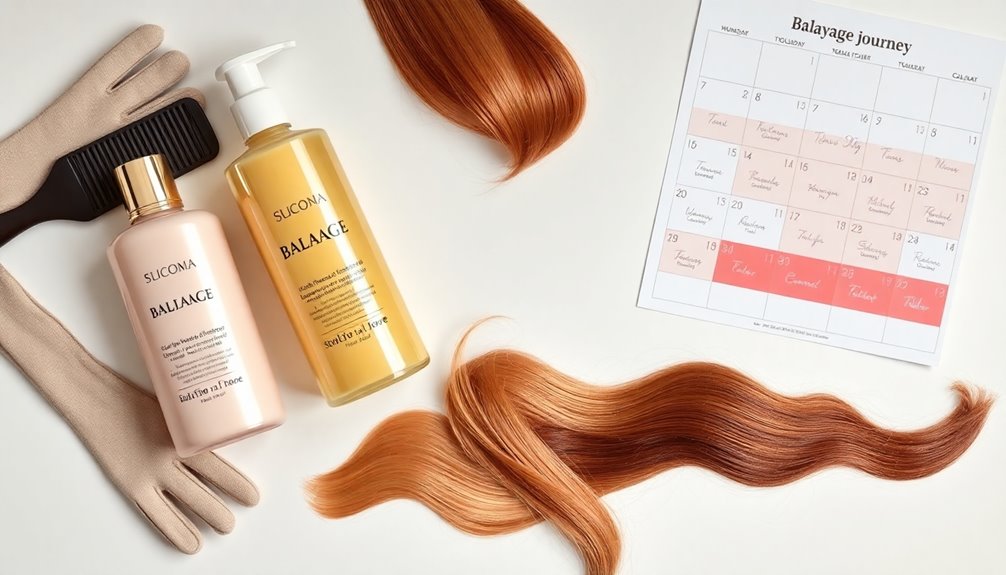
After mastering post-treatment care, establishing a solid home care routine is key to preserving your balayage. Start by waiting at least 48 to 72 hours before washing your hair. This gives the color time to set and the cuticle a chance to close.
Limit your washes to 2-3 times a week, using cool or lukewarm water to reduce color fading. Opt for sulfate-free, color-safe shampoos, and use dry shampoo between washes to keep your hair fresh without stripping its natural oils.
Minimize heat styling to prevent fading and damage. Whenever you do style, always use a heat protectant spray and choose lower heat settings. Consider air-drying or using a diffuser for gentler styling options. This is especially important for avoiding root damage that can occur with frequent heat application.
Incorporate deep conditioning treatments one or two times a week to keep your hair hydrated. Use rich oils like almond or argan oil and apply leave-in conditioners for extra moisture.
Regularly check your hair for dryness, fading, or brassy tones, and consult with your stylist for tailored advice. Scheduling balayage touch-ups every 3 to 4 months will help maintain vibrancy and health.
Recommended Hair Products

To keep your balayage looking fresh and vibrant, it's crucial to choose the right hair products. Start with color-safe, sulfate-free shampoos that extend the longevity of your hair dye. Gentle formulas preserve your balayage color while keeping your hair healthy, so avoid harsh shampoos that strip away color.
Look specifically for shampoos designed for color-treated hair that maintain moisture and reduce fading.
When it comes to conditioners, opt for deep conditioning treatments that restore moisture and strengthen your hair. Rich, hydrating conditioners improve elasticity and reduce frizz, focusing application on the mid-lengths and ends to combat dryness from balayage.
For additional care, consider incorporating a purple shampoo into your routine to combat brassy tones, using it just once or twice a week. Hair masks can help maintain hydration and prevent fading, while leave-in conditioners offer extra protection.
Don't forget about dry shampoo for extending time between washes without stripping natural oils, and anti-frizz oils for weekly treatments. Additionally, maintaining proper hydration and nutrition is essential as it can influence the overall health and appearance of your hair, similar to the role of hydration in gout management.
Importance of Salon Visits
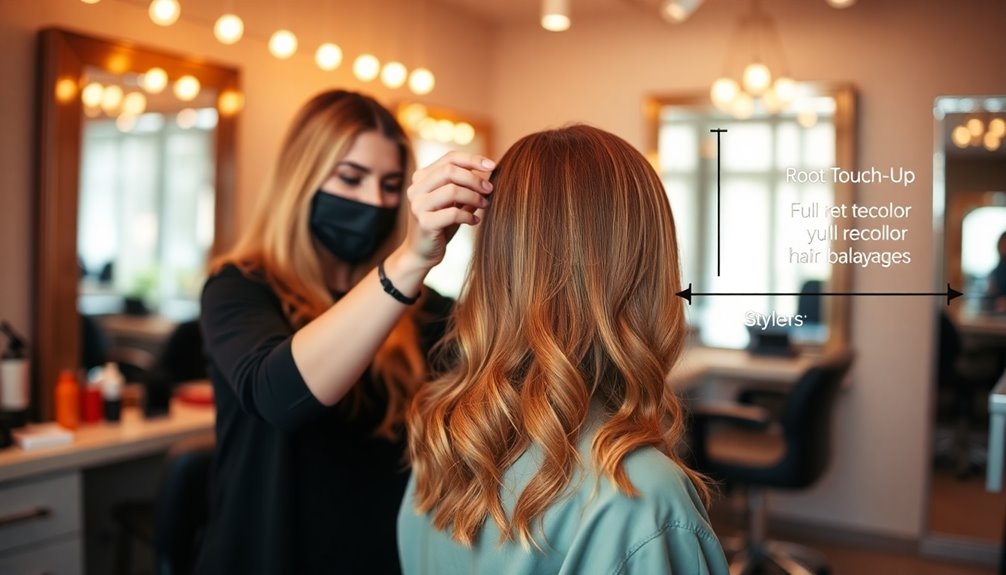
Regular salon visits are essential for maintaining your balayage's stunning appearance and health. Typically, you should schedule touch-ups every 3 to 4 months to keep the vibrancy of your color. As your hair grows, the contrast between your roots and balayage can become noticeable, making it crucial to blend them seamlessly for a natural look. If your color starts to fade or lose its luster, it's time for a visit. Additionally, using high-quality hair products can help prolong the life of your balayage.
During your appointments, your stylist will assess the health of your hair, checking for dryness, rough texture, or split ends. These signs indicate that your hair needs professional care, which can help prevent further damage. Additionally, maintaining a seamless blend of tones is essential to keep your balayage looking fresh and natural.
Your stylist will also customize your highlights, adding baby lights or refreshing toners to maintain your desired shade and avoid brassiness.
Open communication with your stylist is vital. Share your concerns and desired changes so they can provide personalized advice and recommend the best products for home care.
Regular visits ensure that your balayage remains vibrant and healthy, allowing you to enjoy that gorgeous, sun-kissed look without the stress of complex corrections later on.
Deep Conditioning Treatments
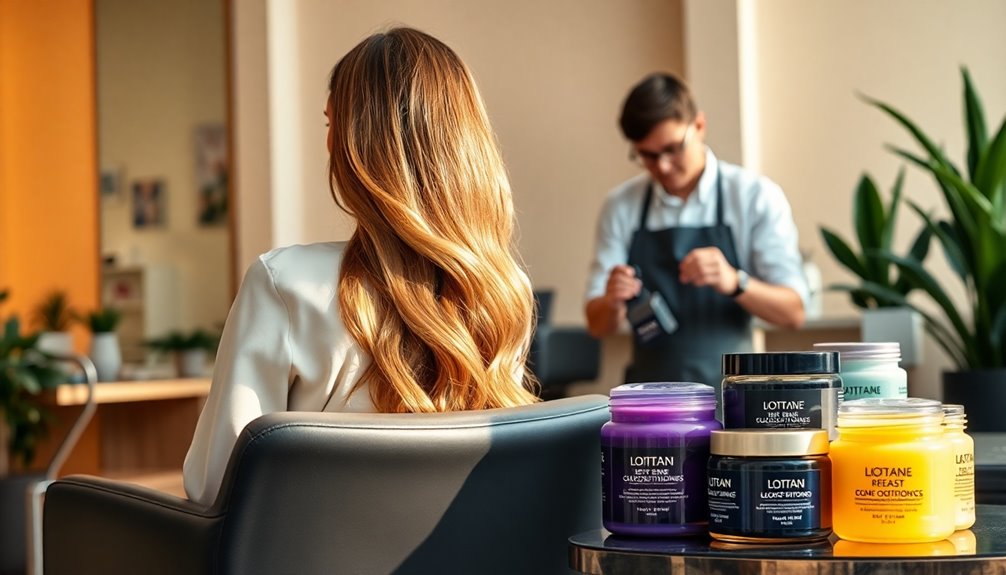
Incorporating deep conditioning treatments into your hair care routine is essential for keeping your balayage vibrant and healthy. Aim to use deep conditioners 1-2 times a week. This regular practice helps maintain moisture and prevent dryness, which is crucial for your colored hair that tends to dry out.
You can choose to deep condition at home or visit a salon, both options effectively restore moisture and strengthen your hair.
The benefits for your balayage are significant. Deep conditioning keeps your hair soft, manageable, and healthy, while improving elasticity and reducing frizz. You'll notice an increase in shine and vibrancy, preventing breakage and damage from coloring and daily stress.
When selecting the right products, opt for deep conditioners rich in moisturizing ingredients and specifically designed for color-treated hair. Look for sulfate-free options to avoid stripping away your color. Natural oils like almond or argan oil can also boost hydration.
To maximize the benefits, integrate deep conditioning into your routine alongside leave-in conditioners for extra moisture. Avoid excessive heat styling and use cool or lukewarm water when washing to help lock in moisture and maintain your balayage's beauty. Additionally, maintaining good oral hygiene habits can support overall health, which is beneficial as your body requires proper nourishment to keep your hair looking its best.
Adjusting Your Maintenance Schedule
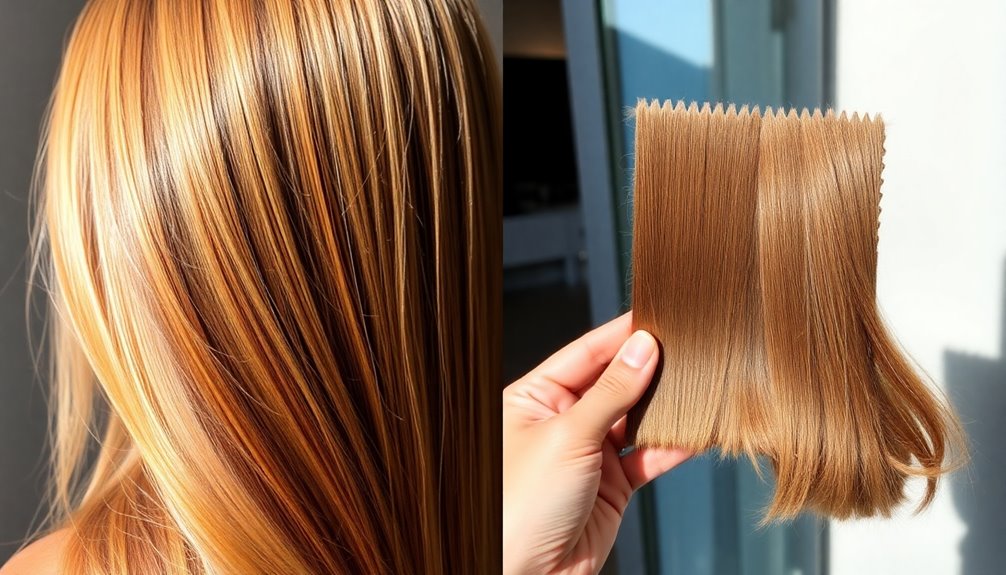
As your hair grows and your balayage evolves, adjusting your maintenance schedule becomes crucial for keeping your look fresh and vibrant. Typically, you'll need touch-ups every 3 to 4 months, but if your hair grows faster, you might find yourself needing them every 8 to 12 weeks.
Pay attention to your roots; if they become visibly noticeable, it's time for a touch-up.
Color fading is another factor to consider. Check your hair in natural light for any dullness or brassiness. To combat this, use color-safe shampoos and conditioners, and incorporate purple shampoo to maintain your desired shade.
Regular toner refreshes can help keep your balayage looking vibrant.
Your hair health also plays a critical role. If you notice dryness or rough texture, it's time to add moisturizing treatments to your routine.
Keep an eye out for split ends, which signal a need for a salon visit. Adjust your washing habits by limiting washes to 2-3 times a week and using cool water to help preserve your color and moisture.
Full Recolor Considerations

Occasionally, you might find that your balayage needs more than just a touch-up. If your color has lost its luster and looks dull or brassy, or if you see visible regrowth lines that no longer blend, it might be time for a full recolor.
Additionally, if your hair appears unhealthy or damaged from color degradation, or if toner refreshes aren't maintaining your desired shade, consider this option.
Before opting for a full recolor, prioritize your hair's health. Deep conditioning treatments are essential both before and after the process. Use sulfate-free, color-safe products to preserve moisture, and incorporate regular hair masks to prevent dryness.
Avoid excessive heat styling to minimize damage and consider using leave-in conditioners for extra protection.
Timing matters too. Generally, full recolors are needed every 6-12 months, depending on growth and fading. If you're looking for a significant change or your roots are prominent, consult your stylist.
They can assess your hair's condition and recommend the best course of action, including necessary treatments and products to maintain your hair's health post-recolor. Regular communication with your stylist will help adjust your maintenance schedule as needed.
Frequently Asked Questions
Can Balayage Work on All Hair Types and Textures?
Yes, balayage works beautifully on various hair types and textures, including fine, thick, curly, straight, and wavy hair. It enhances your natural features, adding dimension and depth while allowing for personalized results that suit you.
How Does Balayage Affect Hair Health Over Time?
Balayage can impact your hair health, leading to dryness and potential breakage. To counteract this, you'll need consistent deep conditioning, regular trims, and protective styling to keep your hair vibrant and strong over time.
Will Balayage Damage My Hair More Than Traditional Coloring?
No, balayage generally won't damage your hair more than traditional coloring. It uses fewer chemicals and targets specific areas, minimizing contact with your scalp and roots, leading to less irritation and healthier hair overall.
Can I Switch Colors During My Touch-Up Appointments?
Yes, you can switch colors during touch-up appointments. Your stylist can adjust highlights or add new tones to suit your preferences. Just communicate your ideas clearly for the best results while keeping your hair healthy.
What Should I Do if I Dislike My Balayage Results?
If you dislike your balayage results, don't hesitate to consult your stylist. They can assess your concerns and recommend adjustments, whether it's a toner refresh, color correction, or a different technique to achieve your desired look.
Conclusion
Maintaining your balayage doesn't have to feel overwhelming. By keeping an eye on your roots and scheduling regular salon visits, you can keep your color fresh and vibrant. Remember to prep your hair before treatments and care for it afterward to extend the life of your look. If you notice signs it's time for a touch-up, don't hesitate to adjust your schedule. Embrace the beauty of your balayage and enjoy the compliments that come your way!
